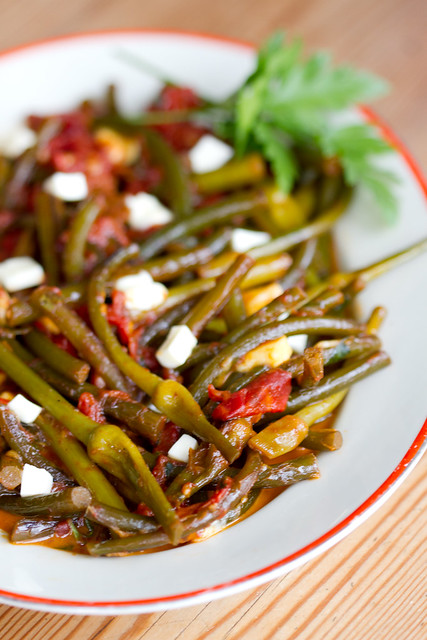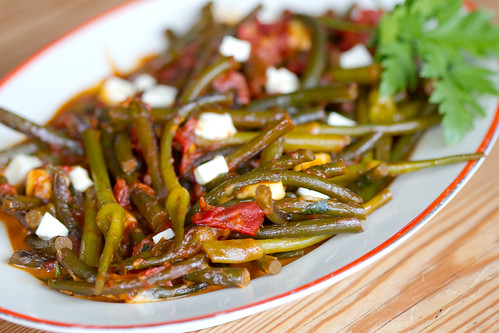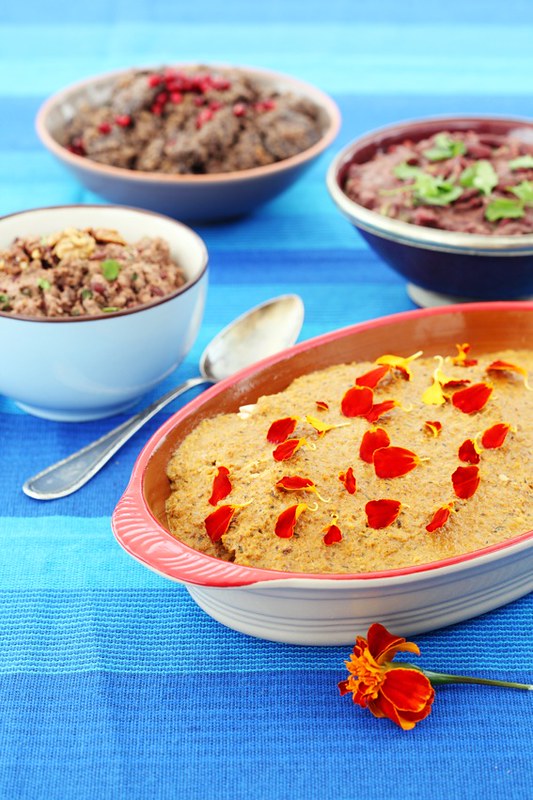
Are you familiar with garlic scapes? I've actually mentioned them here on my blog, Nami-Nami, just over ten years ago (YES, NAMI-NAMI BLOG QUIETLY CELEBRATED ITS 10 BLOG ANNIVERSARY IN MID-JUNE) - when I was still living in Edinburgh. I used to go to the fabulous Edinburgh Farmers Market every weekend, and it's there that I first encountered those spindly scapes, at the stall of Really Garlicky Company (I'm thrilled to see that they're still going strong, those Scottish garlic heroes). I threw those curly garlic tops into stir-fries back then, or chopped them and added to mash.
I grow some hardneck garlic in our beautiful garden these days as well, tucked between our strawberry plants to keep nasty bugs away. Sometimes - but only sometimes - I remember to snip the curly-spindly scapes off in the spring or early summer. This time I did, and made this lovely sauté with tomatoes and cheese. I found a recipe by William Woys Weaver over at Mother Earth News that sounded lovely. Mr Weaver topped his sautéed garlic scapes with cubed and fried halloumi cheese. Although the Cypriot halloumi-cheese is widely available in Estonia, I had none at home. However, as Mr Weaver mentioned that he got an idea for the dish in Slovenia - where local kajmak cheese* is way more popular than halloumi - and kajmak is similar to feta and bryndza cheese. Luckily I had bought some fresh bryndza cheese as well as Georgian suluguni cheese at the market on a previous day, so I used a mixture of these two instead.
A verdict - lovely and tasty and such a genius way for using up those spindly-curly scapes. One of my 5 aunties and one of my 13 cousins came over for dinner that night and the dish got their approval as well. At least none of us will ever waste any garlic scapes again :)
* A huge thanks to my friend Mann for helping me with the Slovenian cheese terms.
(Hautatud küüslauguvõrsed)
Serves 4

2 Tbsp extra virgin olive oil
2 Tbsp dark brown sugar
250 g garlic scapes
400 g fresh or canned chopped tomatoes
180 ml (about 3/4 cups) dry white wine
sea salt and freshly ground black pepper
1 Tbsp chopped fresh flat-leaf parsley
about 100 g of cheese (crumbled brynza or feta or cubed and fried halloumi)
Trim the garlic scapes by snipping off the thin tip on top of the garlic buds - this would simply burn on your pan. Discard. Cut the rest of the scapes into 5 cm/2 inch pieces.
Heat oil on a heavy frying pan over medium heat. Add sugar, then stir for a couple of minutes to melt and caramelise the sugar. Add the garlic scapes, cover and fry on a moderately high heat for about 3 minutes, shaking the pan every now and then.
Uncover, then add the tomatoes and wine. Cover the pan again, reduce heat and simmer on a low heat for 8-10 minutes, until the garlic scapes have al dente or softened, depending on your preference.
Season to taste, fold in the parsley and scatter with cheese. Serve hot or at room temperature.
























